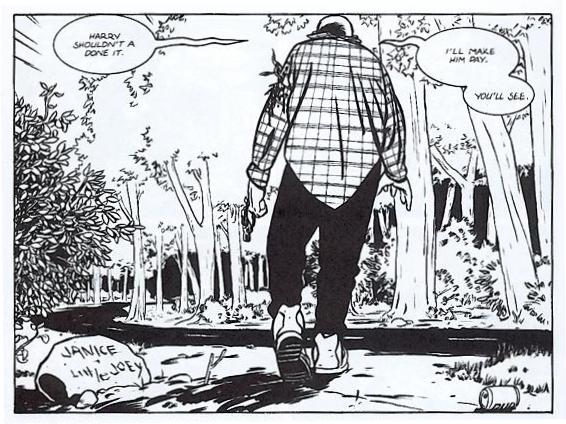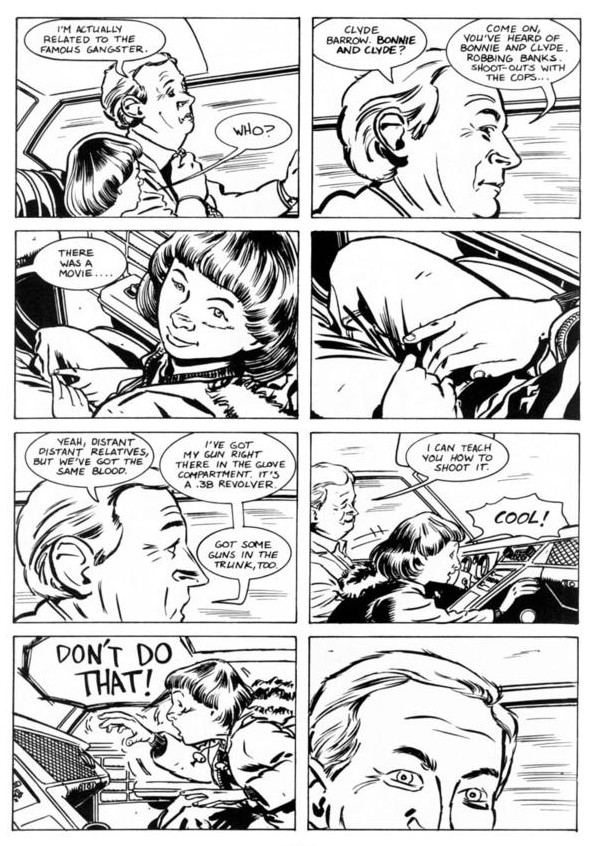Comics at their best represent a direct mind-to-mind connection between artist and reader. The presence of a human hand and human mind in every aspect of text and image brings you as close as you can get to art imitating thought. To read the work of a truly great cartoonist is to be privileged to a guided tour of a private imaginative world.
And so it was a body blow to this remarkable medium when we lost STRAY BULLETS, David Lapham’s self-published oddball auteurist crime epic. Huge in scope and yet utterly personal, driven by twin engines of hope and avarice, animated by a sprawling cast of outlaws, suckers, and irrepressible lowlives, STRAY BULLETS was a ride-along through a wrecked world still shaded with stupid wonder. It was a living world, a tale to get lost in — you wanted to root through these characters’ drawers, raid their drug stashes. And when it abruptly disappeared a decade ago in the middle of a story arc, after forty soulful, disturbing, hilarious issues, the comic shelves were left a diminished place.
Lapham soldiered on as a freelance writer for a slew of books, a job that was surely easier and more financially rewarding than the lonely, punishing slog of life as a self-publishing monthly cartoonist. He was tapped to write books like CROSSED, DEADPOOL and TERROR, INC due to his well-known propensity for Fucked Up Shit, but these dire carnivals of gore and celebrations of violence leave little room for the elements of storytelling that made his earlier work so special — the tenderness and humor which which he illuminates the darkness. Stray Bullets is a book full of doomed people, soul-rotted losers making disastrous decisions, but they have a helpless hopefulness that will break your heart, and a queasy familiarity that elevates these stories above voyeurism. You’re not gawking at the freaks and monsters — you’re relating, empathizing, wondering exactly what separates you from them.
This is the work of a man who should be creating his own stories, not filling up the margins of other people’s properties with what has become a depressing trademark of vileness and desecrations. We got an astonishing window into the ever-more-active underworlds of Lapham’s imagination with 2009’s brilliantly mind-melting short-lived Vertigo series YOUNG LIARS — which made it even more depressing to behold his status as a gun-for-hire, dispensing darkness and assigning grim fates one paycheck at a time. This guy is one of the best storytellers we’ve got, and we need his vision, unadulterated, in the unflashy yet impeccable brushwork of his own hand. And now, as STRAY BULLETS comes roaring back to life with an 1200 page blunt weapon of an omnibus edition and a new continuing series, we have it once again.
STRAY BULLETS foils synopsis because it has no central conceit, not even a particular setting to tie all these intricately interconnected vignettes together. It unfolds from Baltimore to Los Angeles, between 1978 and 1997, but there’s no end game, no plot point that this thing slouches towards as it darts from future to past, from east to west, dropping in and out of continuing stories with little regard for the reader’s confusion, each issue somehow a part of this stunningly detailed universe as well as a thoroughly satisfying self-contained story. Lapham tells the parts and pieces that he finds interesting, tossing us into already-unfolding crises and letting the chips fall where they may, suddenly picking up shards and strands of stories that seemed long forgotten.
To describe its plot threads and subject matter is to depict STRAY BULLETS as so much less than it is. The suitcases of stolen cash & coke, the brutal men and fallen women; the upstanding citizens led down paths of corruption — this is the worn-out stuff of lurid crime fiction and rehashed B-movies. It’s the voice that elevates this material above its strip-mined sources. Lapham never affects the world-weary bitterness of the detective novel or the overheated moral fervor of dime-store pulp. Instead he immerses you in his characters’ worlds, in their hard-clung grievances and unmanageable passions, their twitching anxieties and wounded ambition. For all the cartoonish violence, all the avarice duly punished, Lapham never lets you forget that these characters are human, that the roots of their depravity are just standard-issue vices, cancerously ballooned and uncontainable. Their greed and lust are only the broken, wishful yearning of damaged people.
Though Lapham has almost no regard for chronological storytelling, there’s something cyclical at work here. The story begins in Baltimore, and most of the stories concern relative naifs — upright men, women and children who become mixed up with hardened criminals. By the time everything in Baltimore falls apart and we move westward, for a quiet interlude in the sleepy village of Seaside, NV where a number of the characters go to lay low while the heat dies down. (Seaside, in a perfectly STRAY BULLETS touch of lunatic optimism, is a desert town with a three-mile boardwalk built in anticipation of the moment when California falls into the sea and they become oceanfront property.) The lower stakes stories that take place in Seaside, though still filled with crime and drugs and violence, are as quiet and pleasant as anything in this series — these characters have made their way out of the traps set in Baltimore, but they haven’t reached their final destination: Los Angeles, where so much of the cast washes up, having succumbed to everything, their pasts having caught up with them, their addictions taken hold, hanging on by their fingernails to what little they have left. And then finally back to Baltimore, where Amy Racecar returns home, trailing wreckage and trauma like barnacles and seaweed clinging to her hull.
Which brings us to the greatest character in STRAY BULLETS — the only character who stubbornly refuses to be destroyed, despite all the suffering piled upon her: Virginia Applejack, damaged girl, endangered runaway, avenging warrior, gifted writer, and the ragged, resilient, fucked up soul of this series. We dip in and our of Virginia’s story, following her through the death of her beloved father, her escape from her hideous mother, through bizarre exploits from coast to coast, as she maneuvers herself into and out of trouble, bravely facing up to every new nightmare with resistance and guile, helplessly causing trouble with her vengeful, compulsive need to mete out justice to all bullies, as she finds her way into the margins or center of every major conflict in this gloriously rambling story. By the time we reach the end of the collection, this ensemble piece has clearly become Virginia’s story, a chronicle of how badly her experiences have marked her, how irreparably she’s been twisted by violence, yet how tenaciously she clings to her pride and virtue.
And, in the biggest stylistic departure from the fervid comic hyper-realism of the book, we are privileged to see the science-fictional stories with which she compulsively fills her notebooks on the road, the exploits of the world-beating outlaw and interstellar adventurer Amy Racecar, her idealized alter ego. These windows into the explosive imagination of this brilliant unschooled child are some of the most moving and fascinating moments in this saga. They allow Lapham to cut loose with wildly propulsive sci-fi storytelling and give us our most intimate look at any character in the book.
We don’t get much interiority from Virginia herself — she’s tougher and more self-possessed than the many weaker, more corruptible characters in the series, who tend to overflow with desire and wear their desperation on their sleeves. We watch Virginia move from disaster to disaster, her face always impassive, mental machinery working invisibly, planning her next move. But in her fiction we see the wages of her damage, her longing for safety, power and respect, her fears and defiance, her astonishing fabulistic ability to transcend every weakness by sheer force of belief and invention.
Amy, the protagonist of her stories as well as the name Virginia goes by on the road, is an absurdist caricature, an ice-cold outlaw with a heart of gold, a world-famous thief with a nation of adoring fans, an infinitely rich crime queen with a strict moral code all her own, who brings down governments, confronts evil where she finds it, plunges into danger unafraid, indestructible, smarter, harder, quicker and cooler than everyone else in the multiverse. For all the silliness in her stories, Amy Racecar is a glowing, iconic presence, and as Virginia’s troubles grow worse and worse we begin to realize that Amy is the wishful icon from which she draws her inexhaustible supply of fortitude. She’s constructed a towering, impermeable myth for herself, and like all the best mythologies it proves to be a well-spring of endless strength and a possible road map to redemption.
Hope and belief are the double-edged sword of STRAY BULLETS. Re-reading the series from end to end, I’m reminded of the inscription on the gates of Hell in Clive James’ translation of the Divine Comedy: “Forget your hopes — they are what brought you here.” That covers most of the stories in this series — muddled men and women, led to Hell down wish-lit paths. But these stories are edged with dreams, full of yearning and sincerity. At their core, these cautionary tales are kind and human. Like all the best noir and crime fiction, they contain enough light to show how deep the dark can be.
-Josh O’Neill







Great commentary, really enjoying the return of this series, I’ve been on board since the beginning
Pingback: Comics for Tarantino fans – part 1 - Gotham Calling